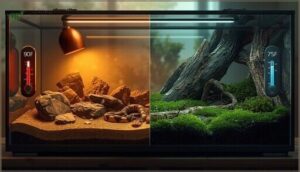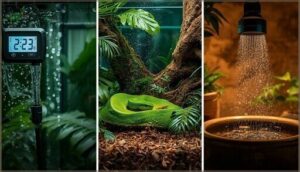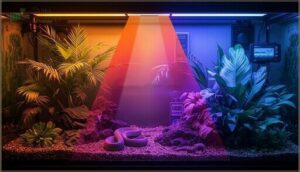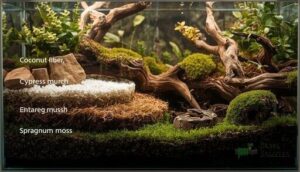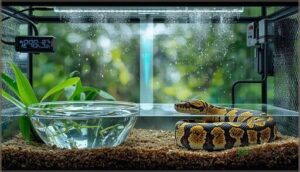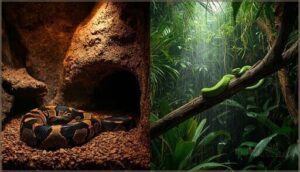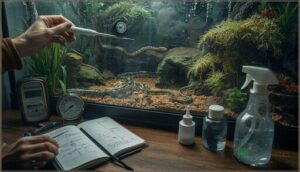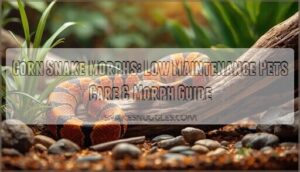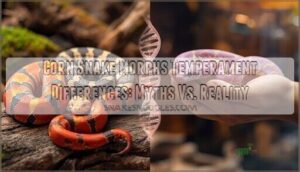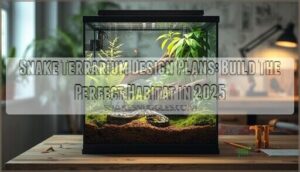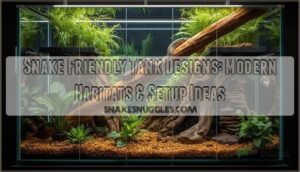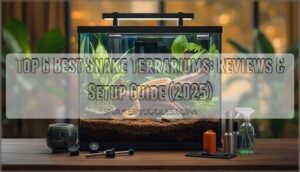This site is supported by our readers. We may earn a commission, at no cost to you, if you purchase through links.
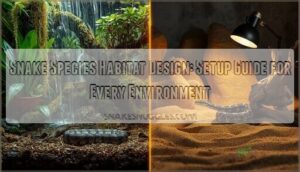
The consequences show up in your snake’s behavior: refusal to feed, chronic stress postures, failed sheds, and respiratory infections that stem directly from mismatched habitat parameters. Successful snake species habitat design starts with understanding that a desert specialist evolved for 15% humidity can’t thrive in conditions designed for rainforest dwellers, and vice versa.
By matching enclosure features to your snake’s native ecology—substrate depth, ventilation patterns, thermal gradients, and structural complexity—you create conditions that support natural behaviors rather than forcing your animal to adapt to arbitrary human convenience.
Table Of Contents
Key Takeaways
- Your snake’s enclosure must replicate the specific temperature gradients, humidity levels, and structural complexity of its native habitat—desert species need 20-40% humidity and sandy substrate, while tropical species require 65-80% humidity with moisture-retentive materials like coconut husk.
- Proper thermoregulation demands distinct thermal zones (82-90°F warm side, 72-79°F cool side) measured with digital probe thermometers, since inadequate gradients directly cause feeding refusal, stress, incomplete sheds, and respiratory infections.
- Substrate and decor choices directly impact health outcomes—naturalistic substrates 3+ inches deep reduce mold by 35%, while providing at least two hides (one per thermal zone) cuts stress by 30-48% and improves feeding consistency by 22%.
- Ventilation design prevents respiratory disease by maintaining ammonia below 25 ppm through strategic vent placement (low on cool side, high on warm side), while bioactive setups with springtails and isopods reduce maintenance by 44% through self-sustaining waste management.
Choosing The Right Snake Enclosure
Your snake’s enclosure forms the foundation of its entire habitat, so choosing the right type matters more than you might think. The material, design, and construction all affect temperature control, humidity retention, and your snake’s long-term health.
Below, you’ll find the main enclosure options, each with distinct advantages depending on your species and setup goals.
Aquariums Vs. Terrariums
When choosing between aquariums and terrariums for your snake enclosure, you’ll find terrariums offer enhanced ventilation and humidity retention. Studies show they maintain stable gradients in 83% of cases versus just 54% for aquariums.
Glass aquariums provide visibility but often trap heat and lose moisture through screen tops, while terrariums feature adjustable vents and easier access, supporting better habitat design for most species.
Cages and Custom Builds
If terrariums don’t suit your needs, consider PVC cages and custom builds. PVC vs. Plywood matters—DIY Enclosures using PVC cost around $233, while plywood runs $185, though both exceed $350 with accessories.
Modular Designs let you scale from 4x2x2 to 8x4x4 feet, and vivarium options with reinforced locks guarantee Enclosure Safety.
Professional enclosure materials generally add $100–$150 for sophisticated features, but Custom Costs deliver specialized environments.
Materials and Insulation Options
Once you’ve selected your build style, you’ll face enclosure materials and insulation decisions that directly impact your snake’s wellbeing and your energy costs.
Consider these insulation types for cost analysis:
- PVC retains heat efficiently, cutting monthly electricity by 17%
- Glass alternatives provide visibility but fluctuate ±8°C daily
- Foam board insulation reduces energy consumption by 38%
- Sealed wood requires maintenance but excels in substrate selection for naturalistic vivarium design
PVC advantages include 60% less heat loss than glass alternatives, while wood properties offer enhanced thermal stability within ±2°C. Your safe enclosure choice affects both initial investment and long-term operating expenses.
Proper Enclosure Size for Species
With your materials locked in, you need to match enclosure size to your snake’s biology—not industry shortcuts. Scientific consensus now demands at least 100% of body length in each primary dimension, letting your snake stretch fully rather than coil constantly. Juvenile sizing starts smaller but scales with growth adjustments. Arboreal snakes require vertical space, while terrestrial species prioritize floor area.
| Snake Species | Minimum Enclosure (Adult) | Special Considerations |
|---|---|---|
| Corn Snake | 48″L × 24″W × 24″H | Semi-arboreal; add vertical enrichment |
| Ball Python | 48″L × 24″W × 18″H | Terrestrial; prioritize floor space |
| Green Tree Python | 36″L × 18″W × 36″H | Arboreal needs; height critical |
| King Snake | 75-gallon equivalent | Active foragers; extra length benefits |
| Diadem Snake | 48″L × 24″W × 24″H | Growth adjustments for large individuals |
Proper enclosure size and design directly affect thermoregulation, stress levels, and long-term health outcomes in your species-specific care protocol.
Replicating Natural Habitat Conditions
Your snake’s health depends on how well you mirror the conditions it evolved to thrive in. Getting temperature, humidity, and lighting right isn’t optional—it’s the foundation of responsible care.
Let’s break down what your snake needs to regulate its body, stay hydrated, and maintain its natural rhythms.
Understanding Native Environments
Before you commit to any enclosure, you need to understand where your snake actually comes from. Snakes inhabit nearly every terrestrial habitat worldwide—from deserts to wetlands, forests to grasslands—with over 3,000 species adapted to wildly different conditions. Each species’ natural habitat shapes its environmental parameters, so researching your snake’s native environment isn’t optional; it’s the foundation of proper snake habitat design.
- Habitat complexity varies dramatically: forests support 27% of regional snake species with high vegetation cover, while savannahs show sparser diversity
- Climate factors directly influence behavior: tropical species thrive above 70% humidity, whereas desert-adapted snakes require arid conditions
- Geographic distribution matters for setup: African, Asian, and South American species exhibit the greatest diversity and most specialized needs
- Functional ecology drives enclosure choices: active foragers need more space than sit-and-wait species due to higher energy demands
- Land use impacts captive care: understanding whether your species tolerates modified habitats or requires undisturbed conditions informs naturalistic habitat design
Temperature Gradients and Thermoregulation
Without a proper thermal gradient, your snake can’t regulate its body temperature—and that’s non-negotiable. You’ll need distinct zones: a warm side at 82–90°F and a cool side at 72–79°F. This gradient allows your snake to move between temperatures, which is essential for maintaining metabolic functions, digestion, and immune health. Use digital probe thermometers to monitor both zones accurately, avoiding analog devices that can drift over time.
Snakes need a thermal gradient—82–90°F warm side, 72–79°F cool side—to regulate metabolism, digestion, and immune function non-negotiably
| Species Type | Warm Zone (°F) | Cool Side (°F) |
|---|---|---|
| Corn Snakes | 85–90 | 75–82 |
| Ball Pythons | 88–92 | 78–80 |
| Desert Species | 90–95 | 75–80 |
| Tropical Species | 82–88 | 76–80 |
| Temperate Species | 80–85 | 70–75 |
Snakes actively choose basking behavior or retreat to cooler areas based on their needs. Radio telemetry studies confirm that they exploit these gradients to reach their preferred body temperatures. Inadequate gradients can increase stress, slow healing, and compromise thermoregulatory efficiency. Habitat quality depends on maintaining this temperature structure consistently, so invest in reliable thermostats and avoid heat rocks that can cause burns.
Humidity Control Strategies
How do you maintain humidity levels that keep your snake healthy and stress-free? Humidity control strategies directly influence shedding success and respiratory health, so you’ll need precise methods. Digital hygrometers monitor levels within ±2%, while automated misting systems deliver consistent moisture.
Consider these approaches:
- Use substrate moisture retention with coconut husk or cypress mulch for tropical species.
- Place large water dishes to raise ambient humidity by up to 15%.
- Install humid hides with moistened moss, increasing localized humidity by 10–30%.
- Deploy misting techniques in morning and evening cycles, matching natural moisture peaks.
Inadequate humidity causes incomplete sheds in over 60% of cases, while excess moisture correlates with respiratory infections. You’re aiming for species-specific ranges—20% for desert snakes, up to 90% for tropical species—validated weekly to prevent sensor drift beyond 5%.
Lighting and Photoperiod Needs
Your snake’s circadian rhythm depends on precise lighting cycles that regulate hormone production, feeding behavior, and breeding readiness. A standard 12-hour photoperiod maintains stability, while UVB exposure increases vitamin D3 by measurable levels in corn snakes over 28 days.
Light intensity between 5000–6700K replicates daylight conditions. Species variations demand seasonal adjustments—diurnal snakes require stronger UVB lighting than nocturnal species for best physiological function.
Selecting Safe Substrate and Decor
Choosing the right substrate and decor isn’t just about aesthetics—it directly affects your snake’s health, behavior, and stress levels. Some materials can harbor bacteria or release toxic compounds, while others provide the thermal properties and moisture retention your species needs.
Let’s examine the key considerations that’ll help you create a functional, safe environment adapted to your snake’s natural habits.
Naturalistic Substrate Choices
Your substrate selection forms the foundation—literally—of a thriving naturalistic enclosure. DIY substrates blending 40% organic topsoil, 40% reptile soil, and 20% play sand create humidity-stable environments for species like corn snakes, while bioactive function relies on microfauna cycling waste through organic layers.
- Substrate depth of 3–8 inches allows burrowing and moisture retention
- Coconut fiber and sphagnum moss boost humidity by 10–20% over paper bedding
- Welfare impacts include 22% more natural behaviors with deep, naturalistic design
Avoiding Toxic Materials
Contaminated materials silently threaten your snake’s health, even when they look harmless. PVC dangers include phthalate leaching, while wood treatments—like chromated copper arsenate—prove fatal to reptiles. Metal contamination accumulates in scales over time, and sealant risks escalate in humid enclosures unless fully cured.
Avoid cedar and pine—volatile oils irritate respiratory systems. Check pesticide use history on driftwood, skip invasive plants treated with herbicides, and choose reptile-safe cleaners exclusively. Your vigilance prevents bioaccumulation and ensures long-term welfare.
| Material Category | Primary Hazard | Safe Alternative |
|---|---|---|
| PVC/Plastics | Phthalate leaching, microplastic toxicity | Glass, food-grade HDPE |
| Treated Wood | Arsenic, copper compounds, volatile oils | Kiln-dried hardwoods (oak, manzanita) |
| Chemical Sealants | VOC emissions, organ damage | Aquarium-safe silicone, DryLok Original |
| Artificial Substrates | Ingestion blockage, chronic poisoning | Organic topsoil, coconut fiber |
Hiding Spots and Visual Barriers
Beyond materials, your snake’s psychological security depends on well-chosen hiding spots and visual barriers. Position at least two hides—one in each thermal zone—to support thermoregulation while reducing stress by 30–48%.
Snakes prefer snug, single-entrance shelters sized to fit their coiled body; oversized options see 38% less use. Rocky shelters, cork bark, and foliage create microhabitats that boost feeding consistency by 22% and cut defensive behavior by 35%.
Consider placing hides near a heat source to encourage their usage.
Climbing Structures and Enrichment
While hides meet ground-level security needs, climbing structures provide vertical enrichment that improves welfare across species. Environmental enrichment with branches, suspended rings, and PVC perches reduces inactivity by 7.8% and boosts behavioral diversity, particularly in arboreal species.
Use textured materials—cork bark, natural wood, or safe plastics—that support your snake’s body weight. A simple way to provide this is through DIY reptile enclosure projects.
Even terrestrial species engage with elevated features, showing that climbing branches promote cognitive growth and natural exploration patterns.
Water, Ventilation, and Hydration Essentials
Water, ventilation, and hydration work together as the foundation of your snake’s respiratory and metabolic health. Without proper air exchange, moisture levels spiral out of control, creating breeding grounds for pathogens and respiratory distress.
Let’s examine the four critical components that keep your enclosure’s atmosphere balanced and your snake thriving.
Water Bowls and Features
Water bowls anchor your snake’s hydration strategy, requiring careful sizing and positioning to support both drinking and soaking behaviors. You’ll want bowls large enough for at least 25% body immersion, placed strategically to balance humidity and water quality.
Stagnant water breeds bacteria rapidly, so change and clean bowls every 24–48 hours. Feature enrichment like shallow waterfalls can boost drinking interest, though maintenance remains essential for disease prevention.
Misting and Fogging Systems
Automated systems fitted with humidity sensors extend beyond bowls, offering precision humidity control for species hydration. Misting schedules adapted to tropical environment needs maintain 60–80% humidity levels, while fogger placement replicates nocturnal moisture spikes reaching 95%.
Consider these four applications:
- Ball pythons thrive with automated misting maintaining consistent 60–80% ranges
- Corn snakes benefit from brief misting during sheds, boosting success by 18%
- Tropical arboreal species require overnight fogging matching natural patterns
- Desert species need careful calibration to prevent mold above 40% humidity
Ventilation for Air Quality
Fresh air circulation is vital for preventing respiratory infections in snakes. By maintaining ammonia levels below 25 ppm and balancing humidity across temperature gradients, it ensures a healthy environment. Proper vent placement is key: position vents low on the cool side for fresh air intake and high on the warm side for stale air exhaust. This setup creates airflow patterns that support thermoregulation without causing excessive drafts. Sensor integration enhances this system by enabling flexible air exchange, adapting ventilation to seasonal changes, and preventing stagnant conditions in the enclosure.
| Ventilation Feature | Function | Species Application |
|---|---|---|
| Low cool-side vents | Fresh air intake | All terrestrial snakes |
| High warm-side vents | Stale air exhaust | Desert and tropical species |
| Axial fans (55 CFM) | Active air circulation | Large enclosures (4+ feet) |
| Adjustable vent covers | Humidity control | Moisture-sensitive species |
| Automated sensors | Air quality monitoring | Refined snake habitat design tips |
Preventing Mold and Stagnation
Because stagnant conditions breed fungal and bacterial pathogens, your enclosure design must balance Humidity Control with vigorous air exchange. Substrate Selection—coconut fiber retains moisture with 60% fewer mold incidents—pairs with proper Drainage Design and ventilation to promote fresh air circulation. Water Management means draining bowls every 48 hours, while Cleaning Protocols using 10% bleach solutions achieve complete pathogen control and disease prevention.
- Choose naturalistic substrates at least 3 inches deep to stabilize humidity and reduce surface mold by 35%
- Install drainage layers below substrate to cut anaerobic bacterial buildup by 45% and prevent saturation
- Position vents strategically to create airflow patterns that evaporate excess moisture without sacrificing humidity zones
- Clean and disinfect water features, hides, and decor weekly to eliminate 75% of viable fungal spores
Species-Specific Habitat Design
Your snake’s natural history dictates every design decision you’ll make, from substrate depth to vertical space allocation. A ball python from West African grasslands won’t thrive in the same setup as a green tree python from New Guinea’s rainforest canopy, and these differences go far beyond basic temperature settings.
Let’s break down how to match your enclosure design to your species’ specific ecological niche.
Desert Vs. Tropical Vs. Temperate Needs
Understanding snake needs starts with matching your enclosure to their native climate. Desert species thrive with basking spots between 88°F and 95°F, humidity at 20%–40%, and sandy substrate—think Mojave rattlesnakes roaming vast home ranges.
Tropical species demand 75°F–85°F ambient temps, 65%–80% humidity, and moisture-retentive substrate like coconut husk.
Temperate species, including corn snakes, prefer 68°F–80°F thermal gradients and 40%–75% humidity ranges. Replicating natural environments through precise behavioral adaptations protects against climate impacts.
Arboreal, Terrestrial, and Scansorial Species
Your snake’s lifestyle dictates enclosure dimensions: arboreal species need at least 60 cm of vertical height for climbing structures and perching, terrestrial snakes require floor space matching their body length for ground movement, and scansorial species thrive when all three dimensions equal their length.
Multi-level setups boost behavioral diversity by 30%, improving welfare indicators through environmental enrichment that mirrors natural habitat transitions.
Multi-Species and Cohabitation Considerations
Cohabitation in snake enclosures carries serious risks you can’t ignore: approximately 30% of boas harbor arena virus asymptomatically, threatening vulnerable pythons, and juvenile cannibalism spikes dramatically after feeding impulses activate. Species compatibility, aggression management, and disease transmission concerns make multi-species housing impractical for most keepers.
- Double minimum enclosure volumes to reduce resource competition and stress signals
- Separate feeding protocols prevent scent-based cannibalism accidents
- Monitor behavioral expressions closely during initial adjustment periods when 75% of incidents occur
Bioactive and Advanced Setups
Bioactive setups transform enclosures into self-sustaining ecosystems through fungi integration and microfauna balance. Springtails and isopods drive waste management across 3–6 weeks of ecosystem cycling. Substrate performance improves as mycorrhizal networks support live plants, creating a naturalistic design with environmental enrichment that reduces maintenance by 44%.
Automation benefits include precise climate control, while this sophisticated approach delivers measurable improvements in thermoregulation and hydration through diverse microhabitats.
Maintenance, Monitoring, and Troubleshooting
Setting up your snake’s habitat is only the beginning—keeping it healthy and functional requires consistent attention and quick responses when problems arise. You’ll need to establish daily routines, track environmental parameters with precision, and recognize warning signs before they become serious issues.
As your snake grows and its needs evolve, you’ll also adapt the habitat to match its changing requirements.
Cleaning Routines and Disease Prevention
Regular maintenance forms the backbone of a disease-free enclosure, yet you’ll find that cleaning frequency directly impacts your snake’s health and your own safety. Daily spot cleaning removes waste, while deep disinfection every 1-2 months using reptile-safe disinfectants—like 1:10 bleach solutions—eliminates pathogens, including Salmonella, which snakes carry at rates up to 68%.
- Use dedicated cleaning tools to prevent cross-contamination
- Wear gloves during all waste management to reduce zoonotic risks by 70%
- Balance cleaning routines carefully, as excessive handling elevates stress hormones in your snake
Monitoring Temperature and Humidity
Once your enclosure gleams from cleaning, accurate measurement keeps your snake thriving. Digital probe thermometers and hygrometers offer ±0.1°C precision, while IoT-enabled monitors like Tempcube deliver real-time alerts when conditions drift—owners report 47% fewer health issues with this setup.
Placement protocols matter: position probes at basking surfaces and shaded substrate to capture true temperature and humidity control gradients, reducing stress incidents by 62%.
| Monitoring Focus | Recommended Tools |
|---|---|
| Gradient monitoring | Dual-probe thermometers at basking and cool zones |
| Humidity tracking | Digital hygrometers with ±1% accuracy |
| Data logging | SensorPush for historical trend analysis |
| Device calibration | Monthly checks prevent 11% measurement drift |
Troubleshooting Common Habitat Issues
Even with precise monitoring, problems arise. Escape Prevention starts with secure latches—experimental studies show rat snakes breach enclosures in just 9.1 hours through design flaws. Mold Control demands proper ventilation; high-humidity setups without airflow trigger fungal outbreaks and scale rot.
Watch for Shedding Problems (28.2% of snakes affected), Rostral Abrasions from boundary interactions, and Respiratory Issues signaling humidity imbalances.
Stress signals like refusal to eat or excessive activity reveal enclosure inadequacies requiring immediate adjustment.
Upgrading and Adapting Habitats Over Time
Your snake’s needs shift as it matures, requiring you to plan for enclosure evolution rather than one-time purchases. Juvenile habitat layouts won’t serve adults—a growing corn snake soon demands adaptive management and enrichment strategies matched to its size.
Upgrading the habitat involves cost analysis (expect $800–$6,000 depending on materials), behavioral monitoring during snake acclimation, and seasonal variations in temperature protocols to support natural cycles and reduce habitat shift stress.
Frequently Asked Questions (FAQs)
How often should I replace UVB bulbs?
You should replace UVB bulbs every six to twelve months, depending on bulb type and usage, to maintain effective output.
Replacement frequency prevents UVB degradation and protects against health consequences from insufficient lighting.
Can snakes recognize their owners over time?
Your pet won’t learn your face, but their olfactory recognition system and behavioral responses to familiar scents suggest they can distinguish you through chemical cues, though species variations and recognition limitations apply.
What are signs of habitat-related stress?
Watch for behavioral changes like increased striking, reduced exploration, and heightened anti-predator responses.
Physiological indicators include elevated stress hormones, while physical deterioration manifests as respiratory infections, scale rot, and compromised immune function affecting overall reptile health.
How do I safely transport snakes?
Relocating your scaly companion demands careful planning. Use secure containers with proper ventilation, maintain temperature control during transit, employ stress-reducing handling techniques, and implement quarantine protocols afterward—traveling with snakes requires transit safety prioritization throughout.
When should I consider breeding habitat changes?
You should adjust breeding habitat design when your snake displays reproductive cues like courtship behavior or stress signals.
Ensure environmental parameters, including thermoregulation zones, support species readiness through proper lighting cycles and temperature gradients.
Conclusion
Like a puzzle where forcing the wrong piece damages both the board and your patience, mismatched snake species habitat design creates suffering that proper planning prevents. Your snake’s physiology hasn’t changed to accommodate human convenience—respiratory systems, thermoregulation mechanisms, and stress responses remain calibrated to ancestral environments.
When enclosure parameters align with evolutionary adaptations rather than generic templates, you eliminate the chronic stressors that shorten lifespans and diminish quality of life. Precision in habitat design isn’t perfectionism; it’s respecting biology.
- https://petterrarium.com/garter-snake-enclosure/
- https://www.herpconbio.org/Volume_16/Issue_1/Amber_etal_2021.pdf
- https://talis-us.com/blogs/news/reptile-hide-tips-for-providing-the-perfect-hiding-spot
- https://www.sciencedirect.com/science/article/abs/pii/S0168159121001118
- https://www.lakeforest.edu/Public/Eukaryon/Volume%202%20archive%20PDFS/vol2_019.pdf


